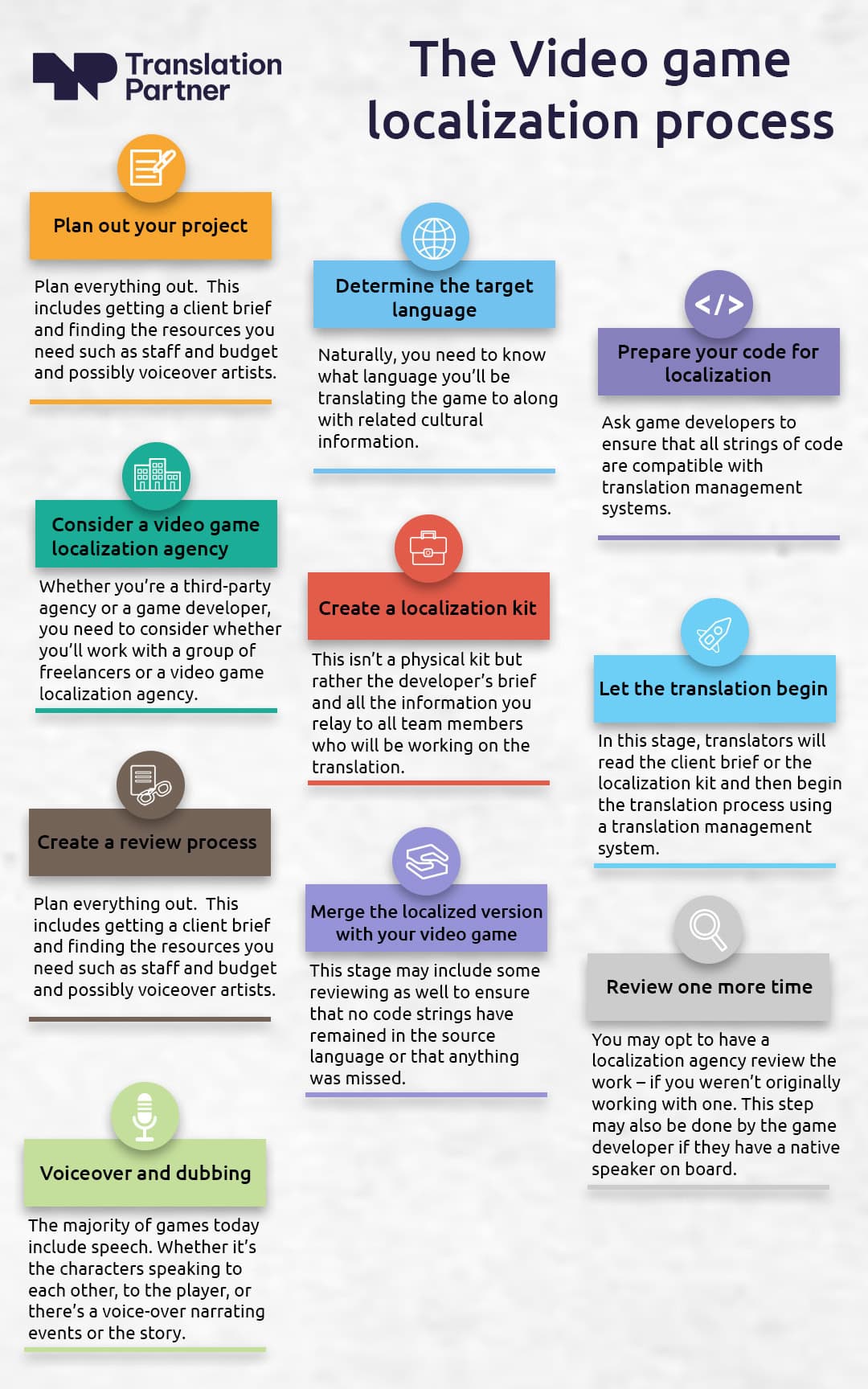The global video game market is a large one with roughly 2.8 billion gamers worldwide in 2020. That’s almost a third of the globe’s 7.9 billion people.
But all of these people don’t speak the same language. And while game developers can easily pick a few main ones such as English, Spanish, and Chinese for game translation, there are hoards of players across the globe eager for an immersive experience.
To get gamers immersed in a video game, you not only need to translate but also to localize your video game.
The video game localization process isn’t just translation. It’s the process of transforming the language and giving it a unique and local flavor.
Localizing a video game means adapting that game to the language used by gamers in a specific country.
Let’s take an example. If you were to localize a video game into Arabic, you’d want to consider which Arab country you’d be localizing the game to. While the 22 Arab countries share a common language, each has its dialect.
So, which one would you pick? The Saudi dialect? The Egyptian one? Or maybe the Tunisian or Lebanese ones?
That’s the difference between video game translation and video game localization. Translation is the larger umbrella.
In this article, we’re going to focus on what goes on in the video game localization process.
A growing video game market
For years, the gaming market has been seeing an upward trend, especially as companies enhance their graphics and technology. In some cases, video game budgets have exceeded that of blockbuster movies, surpassing $100 million.
So it’s only fair that these companies have their video games localized at a top-notch level. Otherwise, they’d have thrown $100 million down the drain.
In 2018, the gaming market was worth $138 billion, whereas the video game localization market made up a meager 1% or $1.3 billion to $1.4 billion, according to Slator’s 2019 Gaming Localization Report.
The report forecast the global gaming industry’s growth to $180 billion in 2021, with more growth in the coming years.
Similarly, Statista forecasts that the global gaming market will reach $268.8 billion by 2025 from its estimated $178 billion by 2021.
“North America is set to remain the top-grossing gaming market worldwide despite strong growth in the Asian region. In-game purchases are estimated to account for more than $74 million worldwide in 2025,” Statista notes.
What this shows is: there’s a growing video game market. This growth should be accompanied by a massive localization spree to ensure a larger geographical footprint and audience, which means more gaming revenues.
Top languages for video game localization
But what are the top languages that video game companies need to consider in their move toward localization?
A survey conducted by Localize Direct found that the languages game companies often translate to are those known as EFIGS. These are English, European French, Italian, Spanish, and German. That’s in addition to Brazilian Portuguese, Russian, Simplified Chinese, Japanese, Korean, and Polish.
According to the report, these 10 languages “accounted for over 80% of the overall word count, from a pool of 45 languages.”
However, other languages are becoming among the best languages for game localization too. These are Vietnamese, Thai, Malaysian, Hindi, Tagalog (Philippines), and Arabic (Saudi Arabia).
As you can see, the focus is on Saudi Arabic, not Arabic in general. That’s because Saudi Arabia is home to 21.2 million gamers, that’s nearly 60% of the country’s 35.5 million population. The kingdom is considered the world’s 19th-largest gaming market.
The video game localization process
Unlike other types of localization, video game localization is no easy feat. It’s a lot of hard work that involves a special process with various steps and facets.
Whether you’re doing the translation yourself, hiring a freelancer, or a localization service provider like TranslationPartner, you need to include all information and facts in your brief.
The facets of the video game localization process include localizing the in-game dialogue, the instructions, terms and conditions, and payment options and explanations. There’s also a technical aspect that pertains to the game’s code strings.

Let’s look at the 10 steps you need to follow if you’re to embark on a video game localization process and project.
1. Plan out your project
First things first: Plan everything out.
This includes getting a client brief and finding the resources you need, such as staff and budget, and possibly voiceover artists.
The translator also needs to know what to translate exactly, which may include translation of the game’s textual and visual elements like signs and billboards.
2. Determine the target language
Naturally, you need to know what language you’ll be translating the game to, along with related cultural information.
3. Prepare your code for localization
Part of the video game localization process is translating some of the game’s strings of code.
Performing this step before you start is considered one of the top video game localization best practices and one that saves you time during the localization process.
Ask game developers to ensure that all strings of code are compatible with translation management systems.
Skipping this step will cause many game localization problems. Chief among them is having untranslated sections and strings when you import the translation into the game.
4. Consider a video game localization agency
Whether you’re a third-party agency or a game developer, you need to consider whether you’ll work with a group of freelancers or a video game localization agency.
Working with a video game localization company, like TranslationPartner, comes with the added benefits of not only getting the localization part done but also the voiceover, dubbing, code localization, and QA and testing.
5. Create a localization kit
An important element in the video game localization process is having a localization kit.
This isn’t a physical kit but rather the developer’s brief and all the information you relay to all team members who will be working on the translation.
A localization kit can include notes mentioned by the developer, words to use or not-to-use, brand considerations, and aspects related to the game itself.
6. Let the translation begin
Now, the hard work of translating and localizing your game begins!
In this stage, translators will read the client brief or the localization kit and then begin the translation process using a translation management system.
7. Create a review process
No work can be fully completed without a reviewing stage. The video game localization process is no exception.
For best results, create a reviewing process and share it with your team.
Having native speakers of the target language in the translation, reviewing, and quality assurance processes will save time and ensure a smoother and clearer translation.
8. Merge the localized version with your video game
Now it’s time to see what happens when the translation meets the code and everything is combined together.
This stage may include some reviewing as well to ensure that no code strings have remained in the source language or that anything was missed.
9. Review one more time
Too many reviews are a bad thing. – Said no one ever!
In this stage, you may opt to have a localization agency review the work – if you weren’t originally working with one. This step may also be done by the game developer if they have a native speaker on board.
10. Voiceover and dubbing
The majority of games today include speech. Whether it’s the characters speaking to each other, to the player, or there’s a voice-over narrating events or the story.
Working with a translation and localization agency usually means that this step is part of your package or contract.
Final notes
Translation is a process that takes time and effort. But the video game localization process is a bigger deal and project altogether.
Unlike other forms of translation, it’s not a page or even a few pages. Localizing a game can take weeks and months, depending on the size of the game.
Understanding the process will help you validate the game translation cost.
Translation companies like TranslationPartner factor three main elements in their pricing process. These are the video game localization itself, the contextual elements like graphics and audio, and the translation software.
Moreover, collaborating with a voiceover artist or agency comes with a separate price tag.
Last but not least, as a game developer, you should know where your top gamers are and what languages to consider.
If you’re looking to break into a new market, you’ll need to couple your marketing efforts with localization to fully reach gamers in that country and give them an immersive gaming experience.

